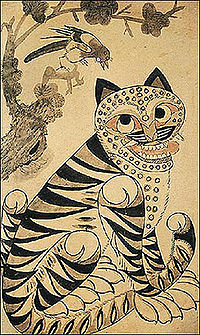- Tiger in Korean culture
-
Tiger in Korean culture 
Minhwa (Korean folk painting)Korean name Hangul 호랑이, 범 Hanja none, 虎 Revised Romanization horang-i, beom, ho McCune–Reischauer horang-i, pŏm, ho Tiger has been strongly associated with Korean people and Korean culture. It appears in not only the Korean foundation mythology but also in folklore, as well as a favorite subject of Korean art such as painting and sculpture. The mascot of the 1988 Summer Olympics held in Seoul, South Korea is Hodori, a symbolized tiger to represent Korean people.[1]
See also
Regarded by many as the divine spirit that guards the West, people in Korea consider the white tiger as a sacred creature in local folklore.
A tiger that has overcome trials and tribulations and understands the world is known to turn white, becoming a white tiger. Although it is a sacred creature that doesn’t harm people, it becomes atrocious when the ruler of the country conducts evil and inhumane deeds. Therefore, it has been told that powerful people become humble and rich people become generous when a white tiger appears.
As such, in Korean history and culture, a tiger is regarded as a guardian that drives away evil spirit and a sacred creature that brings good luck – the symbol of courage and absolute power. The oldest historical record about the tiger can be found in the myth of Dangun, the legendary founding father of Gojoseon, told in the Samguk Yusa, or the Memorabilia of the Three Kingdoms. According to the myth, a bear and a tiger wished to become human beings. The bear turned into a woman by observing the commandments to eat only mugwort and garlic for 100 days in the cave. But the tiger couldn’t endure the ordeal and ran off, failing to realize its wish. There are 635 historical records about tigers in the Annals of the Joseon Dynasty. The story of a tiger that began from a myth can be also found in daily life as well. For example, the 19th century painting named “Sansindo” depicts the guardian spirit of a mountain leaning against a tiger or riding on the back of the animal. The animal is also known to do the errands for the mountain’s guardian spirit which is known to wish for peace and the well-being of the village. So, the tiger was ordered by the spiritual guardian of the mountain to give protection and wish for peace in the village. People drew such paintings and hung them in the shrine built in the mountain of the village where memorial rituals were performed regularly. In Buddhism, there is also a shrine that keeps the painting of the guardian spirit of the mountain. It’s called “Sansintaenghwa”, depiction of the guardian spirit of the mountain and a tiger.
The painting “Jakhodo” is about a magpie and a tiger. The letter “jak” means magpie; “ho” means tiger; and “do” means painting. Since the work is known to keep away evil influence, there is a tradition to hang the art piece in the house in the first month of the lunar calendar. On a branch of a green pine tree sits a magpie and the tiger, with a humorous expression, looks up at the bird. The tiger in “Jakhodo” doesn’t look anything like a strong creature with power and authority. Here again is Gu.
They can be also found around the royal tombs. In front of the burial mound stands the stone tiger sculptures. People believed that tigers also safeguarded the tomb, the permanent home for the dead. The sacredness of the tiger was also utilized for holding rituals that pray for rain. According to the historical records of the early Joseon era, the head of a tiger was offered as the sacrificial offering when performing a ritual praying for rain while Joseon was under the reign of kings such as Taejong, Sejong, Munjong, and Danjong.
References
- ^ "호랑이 [Horang-i (Tiger)]" (in Korean). Encyclopedia of Korean Culture. http://100.nate.com/dicsearch/pentry.html?s=K&i=294761&v=42. Retrieved 8 January 2010.
Categories:- Korean culture
Wikimedia Foundation. 2010.
